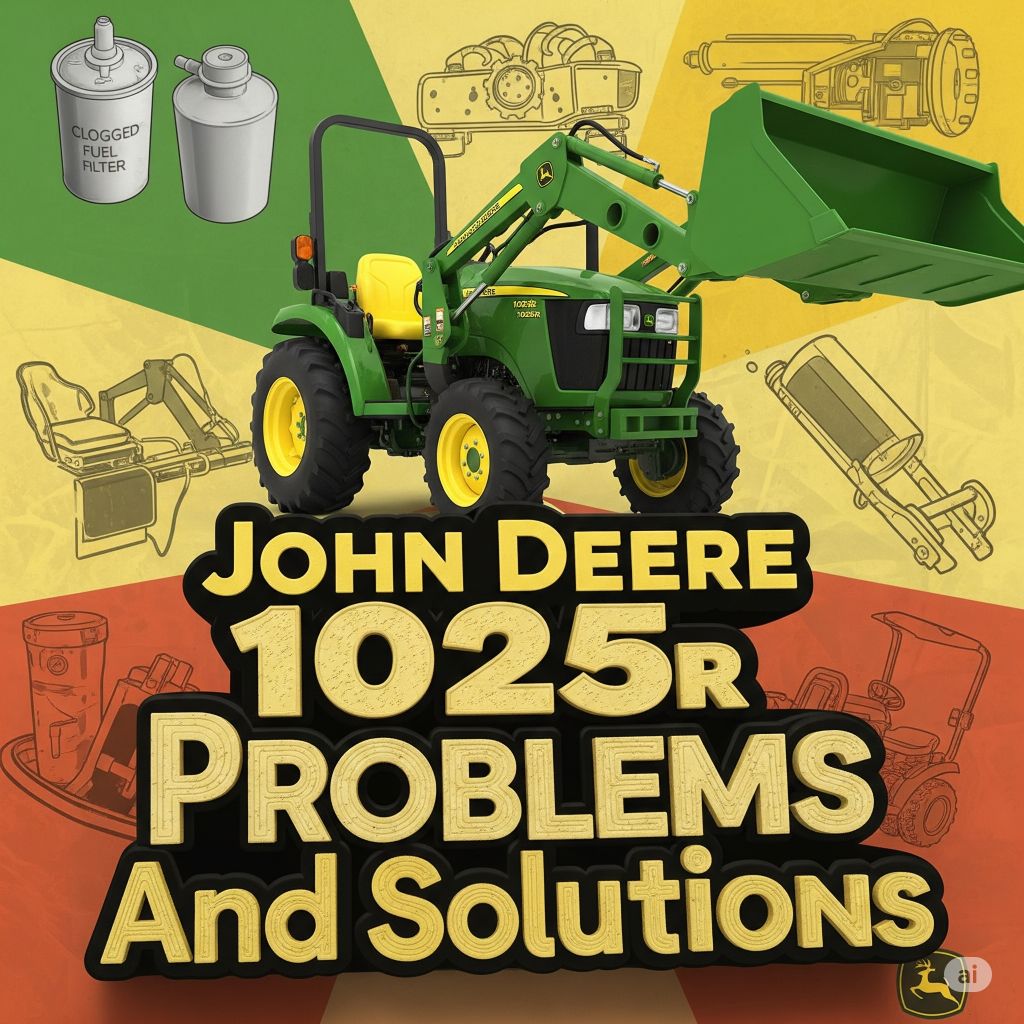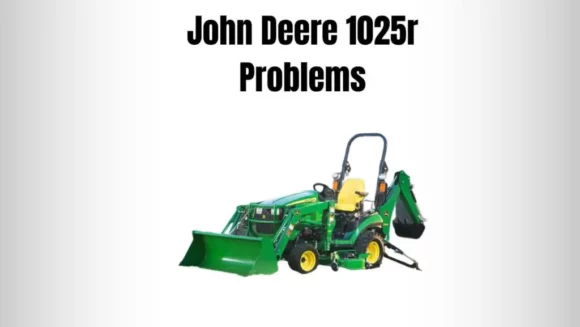
The John Deere 1025R is a best-selling sub-compact utility tractor, widely praised for its versatility, ease of use, and ability to handle a wide range of tasks, from mowing and tilling to loader work and snow removal. Its small size makes it maneuverable, while its capable engine and broad implement compatibility make it a true workhorse for properties of all sizes. However, like any complex machinery, owners may encounter certain issues over time. Understanding these common problems and their solutions can help maintain the 1025R’s performance and longevity.
1. Engine Starting Problems
Symptoms:
- Engine cranks but won’t start.
- No response when turning the key.
- Engine turns over slowly or just clicks.
Common Causes and Solutions:
- Weak or Dead Battery:
- Problem: Insufficient power to crank the diesel engine, especially in cold weather.
- Solution: Test battery voltage (should be 12.6V or higher). Charge or replace the battery. Clean corroded terminals and ensure all connections are tight.
- Fuel Issues (Diesel):
- Problem: Clogged fuel filter, air in the fuel lines (from running out of fuel), water in the fuel, or stale/contaminated diesel. Diesel engines are highly sensitive to fuel quality.
- Solution: Replace the fuel filter. Bleed air from the fuel system (refer to manual for procedure). Drain and refill with fresh, clean diesel. Use a fuel conditioner/anti-gel in cold weather.
- Glow Plug System Failure:
- Problem: Faulty glow plugs or glow plug relay can make starting difficult or impossible in cold conditions.
- Solution: Test glow plugs for continuity. Replace any non-functioning glow plugs. Check the glow plug relay for proper function.
- Safety Interlock Switches:
- Problem: Faulty or disengaged safety switches (e.g., PTO engaged, not in neutral, seat switch) prevent starting.
- Solution: Ensure the PTO is disengaged, the transmission is in neutral (or park), and you are properly seated. Inspect switches and their wiring.
2. Loss of Power / Engine Performance Issues
Symptoms:
- Engine bogs down easily under load.
- Reduced PTO power or hydraulic performance.
- Excessive black or white smoke from the exhaust.
- Engine runs rough or misfires.
Common Causes and Solutions:
- Clogged Air Filter:
- Problem: Restricts airflow to the engine, causing a rich mixture, power loss, and potentially excessive black smoke.
- Solution: Inspect and replace the air filter regularly, especially when operating in dusty environments.
- Fuel System Restriction:
- Problem: Clogged fuel filters, restricted fuel lines, or a failing fuel pump can starve the engine of fuel.
- Solution: Replace fuel filter(s). Inspect fuel lines for kinks or damage. Test fuel pressure and replace fuel pump if weak.
- Dirty Fuel Injectors:
- Problem: Clogged or worn injectors can lead to poor fuel atomization, reduced power, and rough running.
- Solution: Use a diesel fuel system cleaner. If problems persist, professional testing and cleaning/replacement of injectors may be required.
- Exhaust/DPF Issues (on some later models/regions):
- Problem: If equipped with a Diesel Particulate Filter (DPF), a clogged filter can severely restrict engine performance.
- Solution: Ensure DPF regeneration cycles are completed. If heavily plugged, forced regeneration or cleaning/replacement by a dealer may be necessary.
- Hydraulic System Overload:
- Problem: Sometimes, perceived engine power loss is actually the hydraulic system working too hard due to a faulty relief valve or a severe hydraulic leak within an implement.
- Solution: Disconnect implements to see if engine performance improves. Test hydraulic pressure.
3. Hydrostatic Transmission Issues
Symptoms:
- Tractor moves slowly or loses power.
- Transmission feels weak or sluggish.
- Unusual whining or grinding noises from the transmission.
- Tractor will not move forward or backward.
Common Causes and Solutions:
- Low or Contaminated Hydrostatic Fluid:
- Problem: Insufficient fluid or fluid that has degraded over time loses its ability to transfer power efficiently, leading to overheating and component wear.
- Solution: Check hydrostatic fluid level (often shared with hydraulic system). Ensure it’s at the correct level and appearance. Change fluid and filter according to service manual.
- Clogged Hydrostatic Filter:
- Problem: Restricted fluid flow to the pump/motor leads to reduced performance and potential damage.
- Solution: Replace the hydrostatic filter regularly.
- Air in the Hydrostatic System:
- Problem: Can occur after fluid changes or if a line/seal has leaked. Causes spongy pedal feel and erratic movement.
- Solution: Bleed the hydrostatic system (refer to manual for procedure). This usually involves cycling the forward/reverse pedals and the 3-point hitch several times.
- Linkage/Pedal Issues:
- Problem: Bent or seized pedal linkage can prevent full engagement.
- Solution: Inspect pedals and linkage for obstructions or damage. Lubricate pivot points.

4. Hydraulic System Malfunctions (Loader, 3-Point Hitch, SCV)
Symptoms:
- Slow or unresponsive loader arms/bucket.
- Weak lifting/digging force from 3-point hitch or loader.
- Leaks around hoses, cylinders, or Selective Control Valves (SCVs).
- Implement drifts down when held up.
Common Causes and Solutions:
- Low Hydraulic Fluid Level:
- Problem: (Often shared with hydrostatic system) Insufficient fluid causes poor performance and can lead to pump damage.
- Solution: Check fluid level. Top up with the specified hydraulic fluid.
- Clogged Hydraulic Filter:
- Problem: Restricted fluid flow leads to reduced performance.
- Solution: Replace hydraulic filter(s) regularly.
- Faulty Relief Valve:
- Problem: A sticking or worn relief valve allows hydraulic pressure to bypass, resulting in weak performance.
- Solution: This typically requires professional diagnosis and repair.
- Worn Cylinder Seals or Hoses:
- Problem: Internal bypass in cylinders (causing drift) or external leaks from hoses reduce hydraulic force.
- Solution: Inspect cylinders for external leaks. Replace worn hoses or rebuild leaky cylinders.
5. Electrical System Problems
Symptoms:
- Dashboard warning lights or error codes.
- Lights or accessories not functioning.
- Battery not charging.
- Intermittent starting.
Common Causes and Solutions:
- Weak Battery/Charging System:
- Problem: (See starting problems).
- Solution: Test battery and charging system output (alternator). Replace if faulty. Ensure all battery cables are clean and tight.
- Blown Fuses/Faulty Relays:
- Problem: Overloads or shorts can cause fuses to blow or relays to fail.
- Solution: Locate the fuse box(es) (consult manual). Check and replace any blown fuses. Test suspected relays.
- Loose/Corroded Connections:
- Problem: Wiring and connections exposed to the elements can corrode or vibrate loose.
- Solution: Inspect all electrical connectors, especially those exposed to the elements. Clean with electrical contact cleaner and apply dielectric grease.
Preventive Maintenance is Key
Many of these common issues can be prevented with regular, diligent maintenance:
- Follow Service Intervals: Adhere strictly to the maintenance schedule in your owner’s manual for all fluid, filter, and lubrication changes.
- Daily Checks: Before operation, quickly check fluid levels (engine oil, coolant, hydraulic/hydrostatic), and visually inspect for leaks or damage.
- Keep it Clean: Regularly clean the radiator, engine bay, and undercarriage to prevent debris buildup that can cause overheating or interfere with components.
- Use Genuine Parts & Fluids: While aftermarket options exist, using genuine John Deere parts and recommended fluids often ensures optimal performance and longevity.
John Deere 1025R Specifications
The John Deere 1025R is a very popular sub-compact utility tractor, known for its versatility, ease of use, and compatibility with a wide range of implements for property maintenance.
| Specification Category | Feature | Details |
|---|---|---|
| Engine | Type | Yanmar 3-cylinder, liquid-cooled, diesel |
| Displacement | 0.993 L (60.6 cu. in.) | |
| Gross Engine HP | 23.9 hp (17.8 kW) @ 3200 RPM | |
| PTO HP (Hydro) | 18.0 hp (13.4 kW) | |
| Fuel Capacity | 6.1 US gal (23.0 L) | |
| Drivetrain | Transmission | Hydrostatic (2-range, twin touch pedals) |
| Drive | 4WD (selectable) | |
| Forward Speed | Up to 9.1 mph (14.6 km/h) | |
| Rear PTO | 540 RPM | |
| Mid PTO | 2100 RPM | |
| Hydraulics | Type | Open center |
| Pump Flow (Total) | 5.3 GPM (20.0 L/min) (Hydrostatic: 2.5 GPM, Steering/Implement: 2.8 GPM) | |
| 3-Point Hitch Category | Category 1 | |
| 3-Point Hitch Lift Capacity (24″ behind link ends) | 681 lbs (309 kg) | |
| Dimensions & Weight | Wheelbase | 64 in (1,626 mm) |
| Overall Length (w/ 3-pt hitch) | 94.5 in (2,400 mm) | |
| Overall Width | 47 in (1,194 mm) | |
| Height (ROPS) | 84 in (2,134 mm) | |
| Ground Clearance | 6.9 in (175 mm) | |
| Operating Weight (with ROPS) | 1,444 lbs (655 kg) (base tractor without ballast/loader) | |
| Tires | Standard Options | Industrial (R4), Turf (R3), Agricultural (R1) |
| Operator Station | ROPS | Foldable ROPS (Roll-Over Protective Structure) |
| Steering | Power steering | |
| Other Features | Loader Compatible | Yes, e.g., 120R Loader (optional) |
| Mid-Mount Mower Compatible | Yes (AutoConnect™ deck available) |
John Deere 1025R Error Codes
The John Deere 1025R is equipped with an electronic control system that monitors various engine, transmission, and electrical parameters. When a fault is detected, the Electronic Control Unit (ECU) stores a Diagnostic Trouble Code (DTC) and may illuminate a warning light on the instrument cluster.
How Error Codes Are Displayed
Error codes on the 1025R are typically displayed on the instrument panel (often a small digital screen within the dash).
- Warning Lights: Specific icons (e.g., Check Engine, Oil Pressure, Battery, Glow Plug) will illuminate.
- Digital Display: The digital display (where the hour meter or PTO indicator is usually shown) will often present an alphanumeric code. John Deere often uses a system where codes are preceded by a “U” (for User/Operator) or an “S” (for Service/System). Some codes might also appear in the industry-standard SPN (Suspect Parameter Number) and FMI (Failure Mode Indicator) format.
Example Code Display: You might see something like U05 or S12 or SPN 110 FMI 3.
Accessing Error Codes
- Automatic Display: Active (current) faults will typically display automatically on the digital screen and/or illuminate a warning light.
- Checking Stored Codes: To check for stored (historical) codes, you may need to navigate through the display menu using buttons on the dash. The exact procedure is described in detail in your John Deere 1025R Operator’s Manual. This manual is crucial for interpreting the “U” and “S” codes specific to your tractor.
- Dealer Diagnostic Tool: For comprehensive diagnosis, viewing live sensor data, performing calibrations, and clearing certain codes, a John Deere dealer will use specialized diagnostic software (like Service Advisor) connected to the tractor’s diagnostic port.
Common Error Code Categories and Their General Meaning
Here’s a breakdown of common types of faults the 1025R’s system monitors and will generate codes for:
- Engine Related:
- Fuel System: Codes for low fuel pressure, water in fuel, clogged fuel filter, issues with fuel injectors or fuel pump.
- Air Intake/Exhaust: Codes for restricted air filter, turbocharger issues (if equipped on some variants), or DPF/emissions system faults (on later models).
- Sensors: Codes for engine coolant temperature, oil pressure, engine speed (RPM), and intake air temperature sensors.
- Glow Plug System: Codes for faulty glow plugs or glow plug relay.
- Transmission/Hydrostatic Related:
- Codes related to hydrostatic system pressure, speed sensors, or control valve issues.
- Codes indicating low transmission fluid or overheating.
- Electrical System Related:
- Battery/Charging System: Codes for low battery voltage, overcharging, or alternator/regulator faults.
- Sensor Voltage Issues: Generic codes indicating a sensor circuit voltage is too high (short to power) or too low (open circuit/short to ground).
- Safety Interlocks: Codes related to seat switch, PTO switch, neutral switch, or brake pedal switch malfunctions.
- Hydraulic System Related:
- Codes for low hydraulic fluid level (often combined with hydrostatic fluid).
- Codes indicating hydraulic pressure sensor issues or control valve faults.
General Fixes for Error Codes
- Record the Code: Always write down the full code (e.g., U05, S12, or SPN/FMI) as displayed.
- Consult Operator’s Manual: This is your first and most important resource for “U” (User) codes. It often lists what these mean and the immediate action to take.
- Basic Checks First: Many issues are simple:
- Fluid Levels: Check engine oil, coolant, and hydrostatic/hydraulic fluid.
- Filters: Inspect air filter, fuel filters, hydrostatic/hydraulic filters.
- Battery/Connections: Ensure battery is charged, and all terminals and ground connections are clean and tight.
- Safety Interlocks: Confirm all safety interlocks (PTO off, in neutral, parking brake set, operator on seat) are properly engaged.
- Fuel Quality: Ensure fresh, clean diesel.
- Wiring and Connectors: Inspect wiring harnesses and connectors for looseness, corrosion, or damage, especially around sensors or switches indicated by the code.
- Bleed Air (Fuel/Hydro): If you ran out of fuel, or changed filters, you might need to bleed air from the fuel system. Similarly, after hydrostatic fluid changes, bleeding the hydrostatic system is crucial.
- “S” Codes and Persistent “U” Codes: If you get an “S” code, or a “U” code persists after basic troubleshooting, it usually indicates a more significant issue requiring specialized tools or diagnosis. This is the point to contact an authorized John Deere dealer.
Conclusion
The John Deere 1025R is a highly versatile and dependable sub-compact utility tractor. Most common problems are typical for diesel-powered hydrostatic machines and can be effectively managed with proactive maintenance and prompt troubleshooting.
By staying vigilant about routine checks and addressing issues early, you can ensure your 1025R continues to perform reliably for all your property needs. For complex issues or those indicated by specific error codes, consulting an authorized John Deere dealer is always recommended.

I’m David man behind Lawn Mowerly; I’ve been dealing with lawnmowers and Tractors with my father since I was a kid. I know every make and model and what each one is capable of and love helping people find the perfect lawn mower for their needs.
